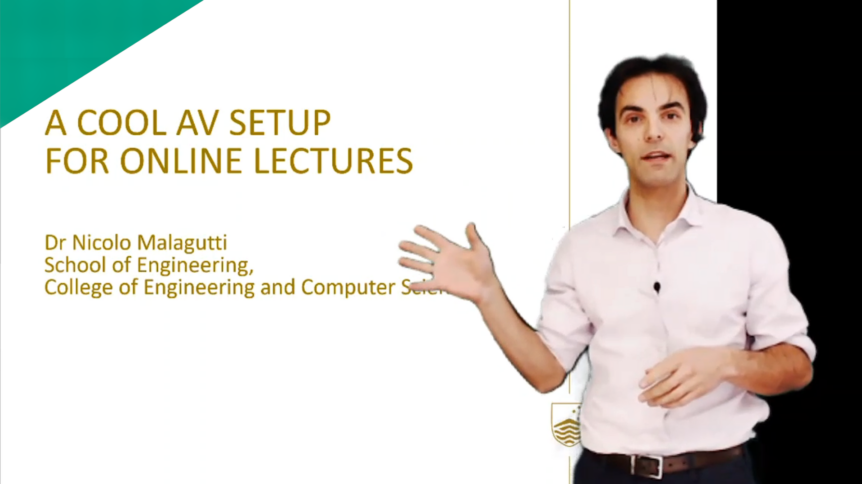Helping deliver personable, engaging live lectures over the online medium
Over many years of lecturing at ANU Engineering, I have convened courses using both traditional and flipped-classroom methods. Regardless of the approach, I have consistently found that a strong rapport with students is key to good outcomes (for Education Psychology leads, see this Noba blog entry).
The rapid move to online learning caused by the pandemic in 2020 seriously challenged my ability to develop a rapport with my students. A patchwork of sub-optimal technological tools and a major shift to asynchronous content fruition introduced an uncomfortable divide between me and the class. I felt abruptly re-cast as an “online content creator” and frustrated by my reduced ability to entertain a dialogue with my students about their learning journey. An opinion piece by Deidre McKenna (BERA) resonated with me, where she highlights that the pursuit of novel tools and techniques must retain a “human” focus. As an engineer, I knew that new tech would not be my stumbling block; rather, how to use it to restore that precious rapport.
My allocation to ENGN2217 Mechanical Systems and Design in Semester 1, 2021 provided the right impetus for experimentation. It was my first time teaching ENGN2217, which had been delivered in a very traditional way for a decade, and I did not have sufficient lead time for a major restructure. Could I work on delivery technology, to create a more worthwhile online class experience for everyone?
I laid out system requirements based on my experience of effective exchanges in a traditional class setting:
- To appear “in person” and be able to use body language to extend verbal communication
- Easy sharing and switching between various content sources, not just slides
- Easy creation and sharing of off-the-cuff content (e.g., annotations, diagrams, etc.)
- Ability for students to “jump in” with their contributions or questions, creating the opportunity for dynamic, live dialogue and interactive content development.
As neither Teams nor Zoom could deliver on all counts, I decided to engineer a custom audio-visual system based on equipment which I either owned or could purchase at an affordable price. I also wanted the solution to be portable, to survive lockdown-related disruptions.
After a few weeks of trials and errors, I finally came up with the set-up illustrated below. Delivery takes place in front of a green screen, which allows for a live stream of the presenter to be superimposed onto content (e.g., PowerPoint) cast from a tablet. A computer screen placed behind the camera allows me to retain spatial awareness with respect to the virtual background. Video mixing is performed by my laptop using the open-source software OBS Studio, which can feed directly into Zoom via its “virtual camera” output.

This set-up allows for my enthusiastic lecturer self not to be compressed into a soporific talking head. The tablet is a fantastic asset for live content selection and switching, and for creating easily shareable content and annotations on-the-go using digital ink. Live student interactions take place via Zoom chat, which I follow on the feedback screen, or via meeting audio, which I receive through a wireless earpiece.
The system takes about 20/30 minutes to set up from scratch and, aside from the technical equipment, only requires a room with diffuse lighting to minimise shadows.
Here is an action shot from my office

And here is a detailed photo of the rest of my wearable tech

My experience of using this custom set-up was generally positive and rewarding. The system really helped me bring a more authentic (and engaging!) version of myself to the class. This was highly valued by the students, with many providing amazing SELT feedback. Regrettably, not all students embraced the opportunity for greater dialogue—a quest for 2022! Even on the tech side there were occasional frustrations, especially with screen casting glitches and fiddly natural light conditions.
I look back on this challenge having learned a lot about tailoring audio-visual technology to the human-centred teaching/learning experience I envisaged for my courses. I would be happy to share technical know-how and generally compare notes over a cuppa with like-minded colleagues at ANU.
August 2021
Dr Nicolò Malagutti is a Lecturer at the ANU College of Engineering and Computer Science.

